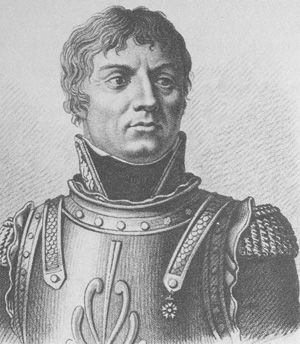General Jean Joseph Ange d'Hautpoul

Born: May 13, 1754
Place of Birth: Cahuzac-sur-Vère, Tarn, France
Died: February 14, 1807
Cause of Death: Mortally wounded
Place of Death: Woryny, Poland
Arc de Triomphe: D'HAUTPOUL on the east pillar
Pronunciation:
Born into a noble family, Jean Joseph Ange d'Hautpoul volunteered to join the dragoons in the Dauphine's legion in 1771. Six years later he was commissioned as a sous-lieutenant in the Languedoc dragoons. Once the French Revolution was underway, d'Hautpoul began rising in rank by being promoted to capitaine in March of 1792 and then to lieutenant colonel in August. In 1793 he served at the relief of Maubeuge and then in February of 1794 he served at Cambrai. It was here that d'Hautpoul was arrested due to his noble birth, but his soldiers adored him so much that they threatened mutiny, and the representatives of the government backed off.1 Afterwards d'Hautpoul was promoted to chef de brigade on March 21st and then two weeks later he received a promotion to général de brigade. That May he was with the Army of the Ardennes in the advance guard and in June he fought at Fleurus . In July d'Hautpoul began serving with the Army of the Sambre and Meuse and in September of 1795 he fought at Blankenberg where he distinguished himself.
The summer of 1796 saw General d'Hautpoul fighting at Altenkirchen in June where he was wounded by a ball to the left shoulder. Richepanse took over his command due to this wound, but when Richepanse himself was wounded that August, d'Hautpoul resumed his command. In October d'Hautpoul received a promotion to général de division. In 1797 he became commander of the heavy cavalry of the Army of the Sambre and Meuse and he served at the crossing of the Rhine in April. Originally designated for the Army of England in 1798, d'Hautpoul took command of the 7th Cavalry Division of the Army of Mainz.
In 1799 d'Hautpoul joined the Army of the Danube and he fought at Ostrach and Stockach in March. At the end of April he was relieved of command due to a complaint from Jourdan that he had disobeyed and missed a charge at Stockach, causing the defeat. A council of war was formed to investigate these allegations. The council of war acquitted him and he joined the cavalry of the Army of the Rhine. In April of 1800 d'Hautpoul was assigned to the Reserve Corps and he distinguished himself at Engen and Biberach in May. That December he took part in the Battle of Hohenlinden where he again distinguished himself.
Next d'Hautpoul became inspector general of cavalry in 1801 and in 1803 he went to the camp of Compiègne. Later that year he took command of the cavalry of the camp of Saint-Omer. When the Grande Armée marched to war in 1805, d'Hautpoul was given command of the 2nd Cuirassier Division in Marshal Murat's Cavalry Reserve. Leading his men into action, he charged the Russian center at the Battle of Austerlitz that December. In 1806 d'Hautpoul was rewarded with a Grand Eagle of the Legion of Honor and appointed a senator. When the war with Prussia began that October, he returned to the army and fought at Jena and Lübeck.
A few months later, on February 6, 1807, during the skirmish at Hoff d'Hautpoul rode his cuirassiers to the rescue of Murat's light cavalry. Successfully driving off the Russians, he returned to the Emperor Napoleon with his armor dented and covered in blood. As he dismounted, Napoleon came up to him and embraced him in thanks for his successful charge. Honored and embarrassed by Napoleon's gesture, d'Hautpoul told him, "Sire, for showing me so great an honor, I must die for your majesty."2
Two days later he participated in the great charges of Eylau but he was wounded in the right thigh by grapeshot. As d'Hautpoul was carried away from the battle, both Doctors Larrey and Percy examined him. Larrey suggested an amputation, while Percy suggested the leg could be saved. Hoping for the best, d'Hautpoul agreed with Percy but he died within a week from the wound.3
Notes
- John R. Elting, Swords Around a Throne: Napoleon's Grande Armée, (USA: Da Capo Press, 1997), 38.
- Robert Richardson, Larrey: Surgeon to Napoleon's Imperial Guard, (London: Quiller Press, 2000), 111.
- Ibid., 114.
Bibliography
- Haythornthwaite, Philip J. Who Was Who in the Napoleonic Wars. London: Arms & Armour, 1998.
- Six, Georges. Dictionnaire Biographique des Généraux & Amiraux Français de la Révolution et de l'Empire (1792-1814). 2 vols. Paris: Gaston Saffroy, 2003.
External Links:
Updated August 2024
© Nathan D. Jensen